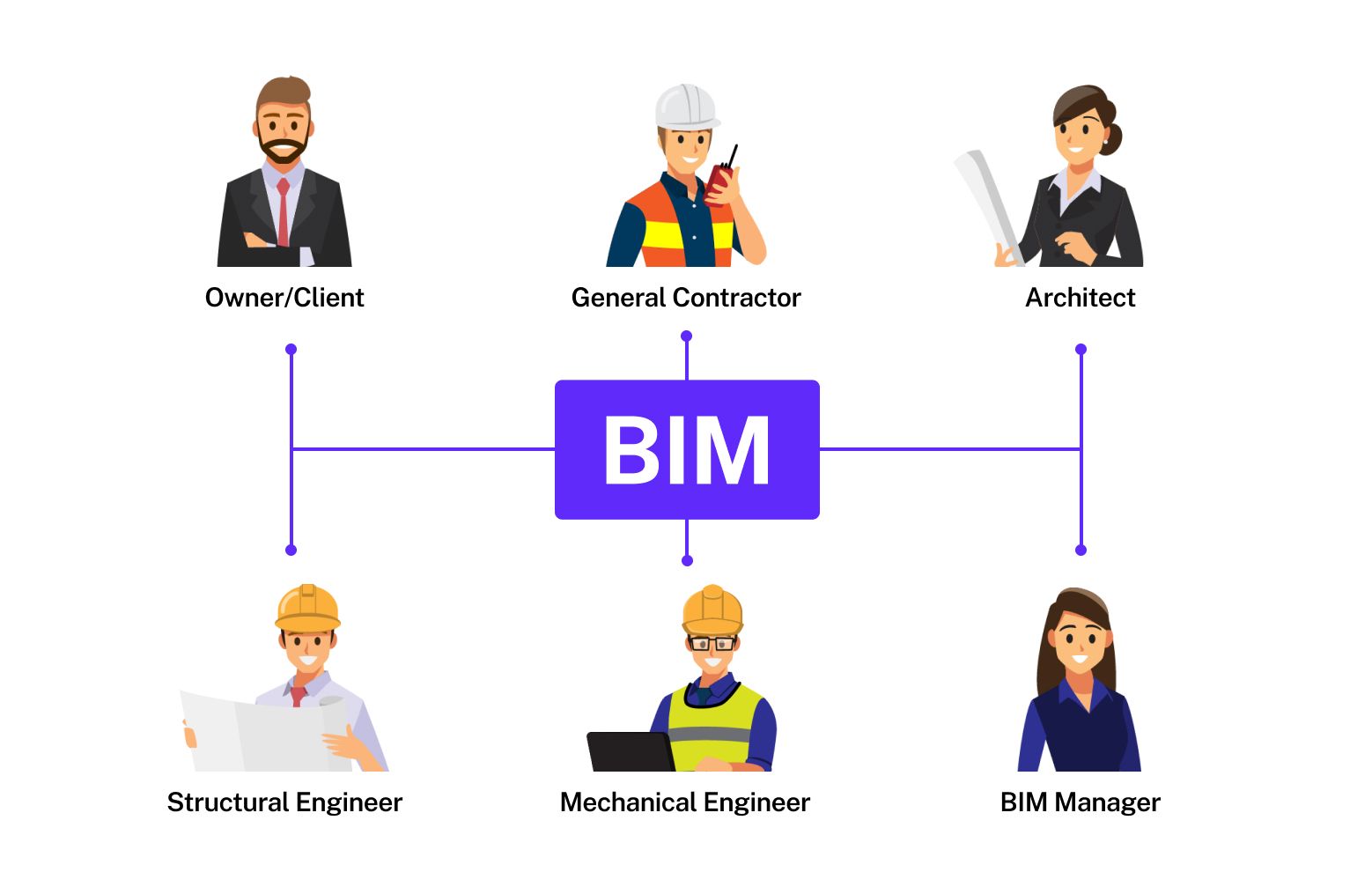Streaming Now – Novatr’s story on The Indian Edtech Story, only on Jio Hotstar.
PROGRAMS
Join thousands of people who organise
work and life with Novatr.
5 Things to Keep in Mind Before Starting Your Career in BIM
Thet Hnin Su Aung
10.5 mins read
June 25


BIM for different AEC professionals (Source: https://archisource.org/)
Is a career in BIM really worth the trouble?
BIM has shown a paradigm shift in the digitisation of the AEC industry. And its adoption across different AEC fields is spreading. It would not be presumptive to say that any AEC professional who has taken up BIM is not looking back. They have personally seen the benefits of BIM, so why would they? Thanks to its soaring popularity, the demand for BIM professionals is also higher than ever. Those equipped with BIM knowledge and skills can enjoy better career opportunities and 40% more pay than non-BIM professionals. So is a career in BIM really worth it? You decide.
What are the career opportunities in BIM?
There are many niches within the industry, and so are a variety of BIM career opportunities, each with its own required skills and responsibilities. You can opt to design and/or draft as your first step into the industry through the roles of a BIM Modeller or a BIM Designer. Usually, one would be a BIM Modeller first before becoming a BIM designer. Being a BIM designer requires not only BIM knowledge but also their respective disciplines. A similar role to this, focusing on an engineering niche, is a BIM engineer.
After gaining experience in these roles, the next step in your career will be to become a BIM manager, wherein you will manage the BIM project, set up the LOD (Level of Development) as per the requirements and perform QC (Quality Check). With sufficient experience to manage both the project and the team, the next role is a BIM coordinator.
If you are well-versed in dealing with construction site issues and other non-BIM professionals working onsite, you can also become a BIM facilitator. You can then become a BIM consultant after years of experience working with BIM in the AEC industry, guiding the firms to handle BIM projects.
These are just some of the common career opportunities in BIM. It is likely that they will increase as technology advances.

What steps can you take to start a career in BIM?
To begin a career in the BIM industry, you should be a graduate in any construction and built environment-related courses. Those from an engineering background, like civil and electrical engineering, can also hold BIM jobs. This is the most basic requirement as the knowledge of design and/or construction is perhaps the most important.

Engineering for BIM (Source: hhttps://www.hilti.group)
1. Join a BIM Course and Get Certified
One does not need a Master’s degree to pursue a career in BIM. However, it is good to go for BIM courses to gain more knowledge and skills, especially practical, to become truly qualified for a career in BIM. Most firms do not ask for certifications; instead, they assess a candidate's practical skills.
2. Choose a Speciality
Despite being considered a specialised profession in design, careers in BIM can be numerous and further narrowed down to more specialisations. Each career opportunity has different requirements in experience and skills. As many as there are, it will be easier to pick one of those choices and focus on being qualified for it. You can climb the career ladder as you gain more experience.
How do you make the right choice? Think about which aspect of BIM your interest lies. As Ami Nigam, an Architect and Design Technology Specialist at UNStudio, suggests, find what your interests are and become an expert in them. After all, interest can drive a person to pursue even the toughest challenges.
Once you have the answer, you can start proper research into related careers and design and construction firms. It is important to check the responsibilities and skills required for a role so that you know you can handle the role well.
Researching design and construction firms should happen simultaneously or afterwards, to truly understand how they utilise BIM in their projects. Based on your findings, you can shortlist ones that align with your interest.
3. Build a Portfolio

MEP BIM model by Santiago Fernandez Bender (Source:https://www.behance.net/gallery/135805131/BIM-Specialist-Portfolio)
Let’s say you find a suitable role and are thinking of applying for it. What should you do next? Create a portfolio! This might actually be the most important step.
For any BIM role, creating and handling BIM models are the basic responsibilities. Show in the portfolio your data-rich BIM models and that you can deliver more than what is expected of you. It will also become a proof of what BIM software and tools you can use. Don’t be shy to showcase as much as you can. It is even better if your projects align with your potential employer’s visions. Most employers prefer candidates with relevant building experience, so if you have work experience in either architecture or engineering fields, remember to highlight them. Do not forget that whatever software and skills you have mentioned in your CV should also be reflected in your portfolio.
What software does one need to know as a BIM professional? With the industry expanding and the workflow getting complex, the number of BIM software available is also increasing (remember, BIM is not software, but a process or technology which forms the basis of the software). For example, knowing Revit alone may not be enough, you would also need a collaboration tool like BIM360, or analysis tools like Cove.tool and IES which are available as Revit plug-ins. The software requirement will depend on your role and responsibilities in the firm you will be working in.
BIM as an industry is growing and more graduates are becoming interested in joining this workforce. You should show that you have something special, be it skill or knowledge, that will attract potential employers.
4. Expand Your Network

People in a network (Source: https://www0.sun.ac.za/cst)
Nowadays, networking has become an essential activity, and skill, for a resourceful career search. Attending BIM forums, webinars and courses are great ways to know professionals in the field, and for them to know you! Listening to talks by industry experts will also give you some ideas on what to expect in a BIM career and how you can get started.
5.Create an Online Presence
Another option to get people’s interest in your works is through the online media. As professionals in the design industry, we should take advantage of social media platforms to show off our works. Pinterest and Instagram have been popular online platforms to showcase your work. For more visibility and interaction with professionals, Linkedin is a better choice. If a recruiter sees your work and thinks you will be a good fit for their office, you may just get yourself an offer!
Food For Thought
Alumni Advice
Getting advice from either an alumnus of a course can help you understand how and in which area you should upskill.
You can also get similar advice by talking to an employee at a firm you are interested in. Additionally, they can share what to expect from the role and responsibilities and the work culture at the firm. If you happen to go for the job interview at the said firm, this is an opportunity to impress the interviewers with your knowledge of the potential employers.
To intern or not to intern?

Benefits of Internship (Source: https://www.businessstudent.com/)
If you are just starting out in the BIM industry, consider doing an internship first before looking for a full-time position. The knowledge you would gain is all based on practical real-world experience, something valuable that all employers seek. If you have only done a theoretical course on BIM, you may find yourself lacking in projects to build up a professional portfolio. Then an internship becomes even more invaluable.
Now, how do you choose the right firm? After all, a bigger firm does not mean it is better. Consider all the factors - like location, pay and even how they use BIM - before making a decision. You should not begin your career with something you would regret later on!
If you want to gain both theoretical and practical knowledge in BIM taught by industry experts, join Novatr’s BIM professional course. Getting to work on real-world RIBA-structured projects is a plus for your portfolio! For more articles on BIM and AEC careers, head to our Resources page.

Join 100,000 designers who read us every month


